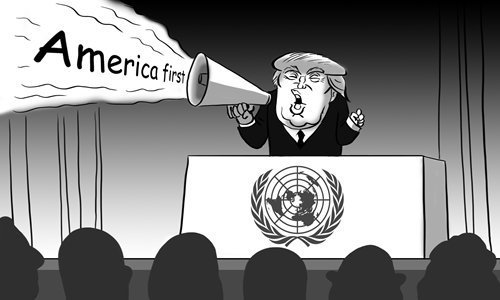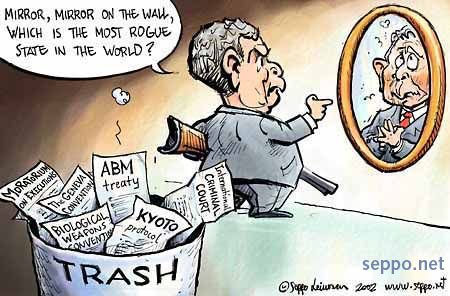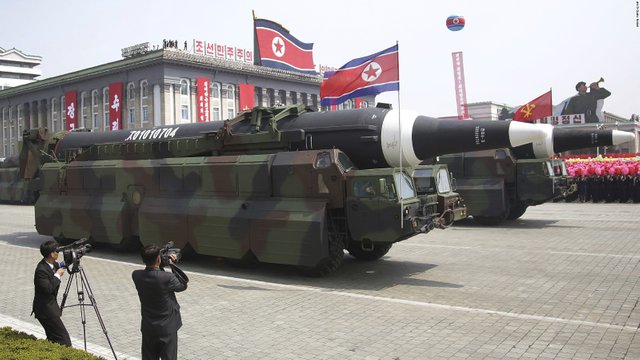Rogue states - Are they the Axis of Evil?
In the kingdom of snakes, exist some species armed with lethal weapons. The King Cobra, for instance, tries to look bigger, releasing its neck ribs when threatened, creating an intimidating spectacle. Nevertheless, it seems to avoid using its poison. The snake is saving its weapon, and most often aims only to scare off its enemies with its threatening attitude.
I.Rogue states and their desire to acquire nuclear weapons
In world politics, this behaviour commonly occurs. There is often a state who tirelessly threatens and demonstrates power to scare off its adversaries. However, questions arise: how much credit can we give to these threats? Where does this lead in the long run? More specifically, what are the motivations for ‘rogue states’ to acquire nuclear weapons?
This article will examine these issues with a particular focus on the Democratic People's Republic of Korea (DPRK). When considering future outcomes of the DPRK’s nuclear arming, the conclusion is simple: the country’s situation will most likely be compromised at some point. Nevertheless, the main aim of this article is to illustrate that from a ’rogue state’ and more specifically an insecure North Korean point of view, the only option for short-term national security (the security of the regime) is to have proven nuclear capabilities.
As Melbourne University professor Dr Paul Monk states, “the North Korean leaders have concluded that the USA might well invade the country if it is not deterred from doing so by a North Korean atomic bomb”.
To gain a deeper understanding of the country’s motivation for acquiring weapons of mass destruction, this paper also aims to delve into North Korea’s history and examine the backgrounds of the DPRK’s nuclear arming.
The term ‘rogue state’ refers to countries that are breaking international agreements and thus pose a threat to the security of other nations. This, interestingly, is mostly defined by the #USA, which could be controversial, as it essentially excludes external influences– for instance, the #UN Security Council’s –and halts international consensus, when determining who falls into that category. As set out in the Charter of the United Nations, if a country feels threatened by any other state they can approach the Security Council to authorise measures to stop the threat in accordance with Articles 41 and 42. However, Professor Noam Chomsky explains: “no state has the authority to make its own determinations on these matters and to act as it chooses”. As mentioned above, one of the main characteristics of a ‘rogue state’ would be that it does not abide these conditions. Considering recent events, the DPRK would fall under this category and so does the USA. There are a series of events in the not too far history of the nation disregarding international agreements and threatening the security of others. Among the long list of precedents could be mentioned the aggression against Cuba, the military invasion of Guatemala, the attack of East Timor by Indonesia with USA military assistance and the bombing of Iraq. For instance, during the 1993 crisis with Iraq, the U.S. went straight against the Charter of the United Nations, when it decided to take matters into its own hands, prioritising the interests of the state above the principles set out in the Charter. As read in Chomsky’s Rogue States: The Rule of Force in World Affairs: Senator John Kerry concluded that “force should be used only if the objective is achievable and meets the needs of your country”. This places anyone aiming to categorise the rogue nations outside the law into a controversial position, as according to the strict definition, the USA would be a prime example of it.
The motivation two possess nuclear weapons thus could be two folded. On one hand, in possession of a great authority (see the USA) it could be used to strengthen its power position and on the other, in the tenure of the less powerful could be used as an armour against the external influences of those great powers. According to Sagan, states seek to acquire nuclear weapons when they feel their security is in danger and that cannot be solved through alternative means.
“While it is not entirely clear how a small nuclear arsenal could effectively be used by North Korea in the event of general war, it is commonly believed that the mere possession of it would deter such a war being initiated by the U.S. or its allies”.
Since North Korea is isolated and vulnerable, it believes that “there is a positive causal relationship between the nuclear weapons program and its own survival” therefore the DPRK should have no current incentive to suspend its nuclear arming. It is a tool to protect the regime and continue the totalitarian dictatorship. The DPRK’s population is irrelevant in this regard, it is the regime that must be safeguarded.

II. North Korea’s quest to nuclear weapons- a brief examination of the DPRK’s weapon program
Understanding why and how North Korea developed its nuclear weapon program is indispensable in order to avoid emotional or biased conclusions. The rhetoric of the Bush and present Trump administration regarding North Korea as the ‘axis of evil’ is now outdated and terribly one-sided.
The North Korean interest in nuclear weapons was first expressed in the 1950’s, as a response to the American threat to use nuclear weapons to end the Korean War. By the 1970’s, under the leadership of Kim Il-sung, North Korea became a military complex, prioritising martial power over any other considerations. This, however extreme, cannot simply be attributed to the supreme leader’s irrational military obsession, as from 1958 until 1991, North Korea was under constant American nuclear threat. Regarding the compromised position of the DPRK, it is no surprise that Kim Il-sung began searching for the means of acquiring nuclear weapons of their own. The solution came from the Soviet Union, and by 1965 a special nuclear research facility was built in the city of Yongbyon. 1965 also marks the beginning of the training of hundreds of North Korean nuclear scientists in the Soviet Union. In 1985 North Korea started a secret mission to build weapons of mass destruction. In addition to the American nuclear threat, the DPRK’s position became further compromised as the Soviet bloc collapsed in 1989, depriving the Republic of their main allies. Not only North Korea was shaken by the breakdown of its satellites, but also, this removed the main sources of economic and military aid Korea had relied upon. Following the Cold War, the unipolar political order featuring the USA as the sole hyper power led to a general uncertainty, where the DPRK and other ‘rogue states’ struggled to re-establish and strengthen their power positions.
Further explanation of the DPRK’s weapon program can be found in the next chapter, where this essay examines how the nuclear arming continued in the context of North Korea’s international relations.
III. North Korea’s international relations
When examining the relationship between the USA and North Korea, it is important to keep in mind, that as the old saying has it: there are two sides to every coin.
Following the collapse of the Soviet Union, the North Korean leadership was forced to come to terms with its worsening predicament, and as a result began to realise that external aid is crucial for the regime’s survival. This culminated in 1991, during a meeting of the ruling Workers Party Central Committee, where it was agreed that the DPRK would suspend (not terminate) its weapon program if an agreement was to be reached with Washington. Diplomatic efforts from both sides led to the signing of Agreed Framework in 1994, an agreement, which granted aid, recognition and security assurances to the DPRK in return for Korea freezing their nuclear weapon program. Mistrust on both fronts – neither party believed the other held up his part of the agreement –, however, led to the breakdown of the Agreed Framework in early 2003, after foreign minister Kang Sok-ju explicitly acknowledged the DPRK’s uranium program and the U.S. as an answer, suspended its heavy oil shipment to North Korea. The North Korean foreign minister claimed the USA’s demands of abolishing the DPRK’s nuclear weapons to be highly controversial, as the U.S. itself was violating the agreement by openly maintaining and developing its nuclear arms. The following statement made by foreign minister Kang Sok-ju in October 2002 expresses the arguable U.S. stance and illustrates North Korea’s rationale:
“We are a part of the axis of evil, and you are a gentleman. This is our relationship. We cannot discuss matters like gentlemen. If we disarm ourselves because of U.S. pressure, then we will become like Yugoslavia or Afghanistan’s Taliban, to be beaten to death”
Following this in 2003, Pyongyang declared that it was proceeding to build atomic bombs “to counter a situation produced by the hostile policy of the United States”.
To implement the key provisions of the Agreed Framework, KEDO was established in 1995 with Japan, the Republic of Korea and the United States signing the Agreement on the Establishment of the Korean Peninsula Energy Development Organisation.
The breakdown of the Agreed Framework led to a general uncertainty in East Asia. Despite the limited military capabilities of the DPRK and its disintegrating economy, the regime’s sporadic behaviour and its nuclear arms posed a great threat on the peninsula. In addition to this, even if North Korea could be deterred from attacking the U.S. or its allies, its nuclear arming could also catalyse a nuclear arms race in the region. In this sense, North Korea’s withdrawal from the Agreed Framework and the Non-Proliferation Treaty (1992) set a dangerous precedent.

IV. Contradictions and concerns
Future generations might wonder how a small nation hardly able to feed its own people has been capable of threatening the sole hyper power and its allies for decades, building and launching ballistic missiles and rockets, conducting nuclear weapon tests and sinking a modern South Korean naval ship, without having to face major consequences (Delpech 2012). The answer to this legitimate question is multifaceted. Firstly, it could be attributed to the DPRK’s possession of nuclear weapons. In this sense, the regime’s extreme focus on nuclear arming did serve as a deterrent force and – so far– has prevented the much-feared U.S. overthrow. In addition to this, North Korea’s primary aim has been to maintain its weapon program rather than to feed its people, spending 22% of its GDP on nuclear development (Amnesty International 2017). Secondly, it was the policy of ‘strategic patience’ implemented under President Barack Obama, in which the USA was willing to look the other way, hoping that things will eventually improve.
However, America’s policy has now changed, and regarding the DPRK’s constant demonstration of power and threatening behaviour, the question arises where does this stalemate lead?
While researchers agree on the extreme degree of jeopardy regarding North Korea, professional opinions differ on this matter. Some argue that China is key in containing North Korea, the DPRK being China’s puppet . Dr Monk claims that there are several plausible options: to increase the pressure on the DPRK; to back off, namely not to restrain North Korea but not to react to its paranoia; or return to an agreement similar to the Agreed Framework (2003). The options are endless, and without exception are extremely hard to orchestrate. One element is certain: any solution would firstly require a major change in both Pyongyang’s and Washington’s approach towards each other.
V. Conclusion
When the King Cobra does bite, however, its victim is dead within minutes. If faced with this creature, the best policy is to avoid confrontation and slowly back off. This cobra is one of the world’s deadliest snakes and must be treated with respect.
North Korea might not be the most powerful, but a regime this insecure and sporadic, armed with atomic bombs, poses a grave danger to not only its neighbours but indirectly to global security. Thus, like the King Cobra, must be handled with the necessary care and attention. North Korea is extremely volatile, and it has its back against the wall. One point, however, is crucial to make. The DPRK is – most likely – not suicidal. North Korea acquired nuclear weapons to protect itself against outside forces, not to obliterate the country. There is rationale in its actions, and as long as this is the case, there is a chance that a neutralising agreement could be reached.
By Nora Bank
References
Chomsky, N 2000, Rogue States: The Rule of Force in World Affairs, South End Press, New York.
Delpech, T 2012, Nuclear Deterrence in the 21st Century, Lessons from The Cold War for a New Era of Strategic Piracy, Rand Corporation.
Freedman, L 2004, Deterrence, Polity Press, Cambridge.
Lee, JH & Chung, IM 2003, The North Korean Nuclear Crisis Revisited: The Case for a Negotiated Settlement, Sage Journals, Security Dialouge vol. 34, no. 2, pp. 2.
Mearsheimer, J. (2014), Structural Realism - International Relations (1/7), onine video, 23 october, The Open University, viewed 19 August 2017, https://www.youtube.com/watch?v=RXllDh6rD18.
Monk, P 2003, North Korea’s Nuclear Program Getting Perspective and Weighing Policy Options, Asia Policy Papers v.1 no. 4, Melbourne.
Mueller, J 2010, Atomic Obsession Nuclear Alarmism from Hiroshima to Al-Qaeda, Oxford University Press.
Sagan, DS 2012, Why Do States Build Nuclear Weapons? Three Models in Search of a Bomb, International Security, vol. 21, viewed 19 August 2017, http://www.mitpressjournals.org/doi/abs/10.1162/isec.21.3.54?journalCode=isec.
Pritchard, LC 2007, Failed Diplomacy: The Tragic Story of How North Korea Got the Bomb, Brookings Istitution Press, Washington.


Congratulations @zyll! You have completed the following achievement on Steemit and have been rewarded with new badge(s) :
Click on the badge to view your Board of Honor.
If you no longer want to receive notifications, reply to this comment with the word
STOPCongratulations @zyll! You received a personal award!
You can view your badges on your Steem Board and compare to others on the Steem Ranking
Vote for @Steemitboard as a witness to get one more award and increased upvotes!